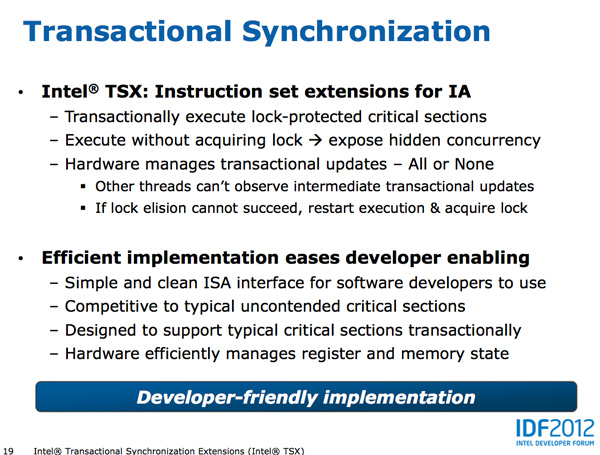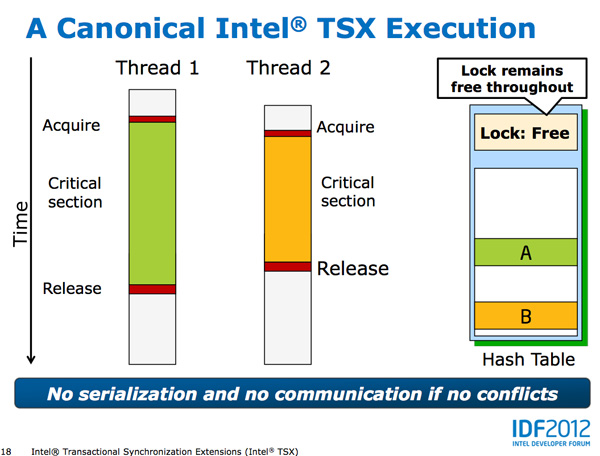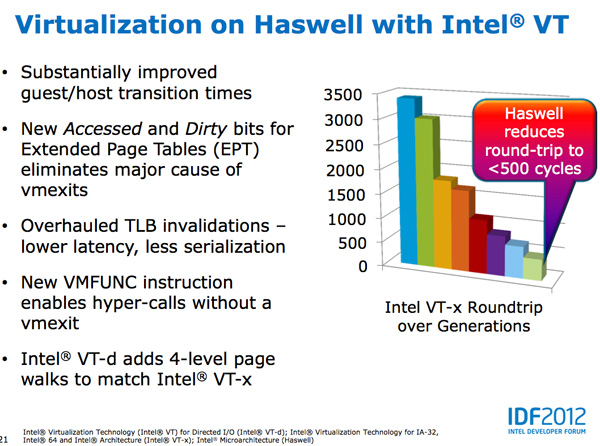Intel's Haswell Architecture Analyzed: Building a New PC and a New Intel
by Anand Lal Shimpi on October 5, 2012 2:45 AM ESTTSX
Johan did a great job explaining Haswell's Transactional Synchronization eXtensions (TSX), so I won't go into as much depth here. The basic premise is simple, although the implementation is quite complex.
It's easy to demand well threaded applications from software vendors, but actually implementing code that scales well across unlimited threads isn't easy. Parallelizing truly independent tasks is the low hanging fruit, but it's the tasks that all access the same data structure that can create problems. With multiple cores accessing the same data structure, running independent of one another, there's the risk of two different cores writing to the same part of the same structure. Only one set of data can be right, but dealing with this concurrent access problem can get hairy.
The simplest way to deal with it is simply to lock the entire data structure as soon as one core starts accessing it and only allow that one core write access until it's done. Other cores are given access to the data structure, but serially, not in parallel to avoid any data integrity issues.
This is by far the easiest way to deal with the problem of multiple threads accessing the same data structure, however it also prevents any performance scaling across multiple threads/cores. As focused as Intel is on increasing single threaded performance, a lot of die area goes wasted if applications don't scale well with more cores.
Software developers can instead choose to implement more fine grained locking of data structures, however doing so obviously increases the complexity of their code.
Haswell's TSX instructions allow the developer to shift much of the complexity of managing locks to the CPU. Using the new Hardware Lock Elision and its XAQUIRE/XRELEASE instructions, Haswell developers can mark a section of code for transactional execution. Haswell will then execute the code as if no hardware locks were in place and if it completes without issues the CPU will commit all writes to memory and enjoy the performance benefits. If two or more threads attempt to write to the same area in memory, the process is aborted and code re-executed traditionally with locks. The XAQUIRE/XRELEASE instructions decode to no-ops on earlier architectures so backwards compatibility isn't a problem.
Like most new instructions, it's going to take a while for Haswell's TSX to take off as we'll need to see significant adoption of Haswell platforms as well as developers embracing the new instructions. TSX does stand to show improvements in performance anywhere from client to server performance if implemented however, this is definitely one to watch for and be excited about.
Haswell also continues improvements in virtualization performance, including big decreases to guest/host transition times.














245 Comments
View All Comments
A5 - Friday, October 5, 2012 - link
8 years is a loooooong time in this space, and yes you (and most people here) are in the minority.Notebooks have been outselling desktops for several years, and in 2011 smartphone shipments were higher than all PC form-factors combined. It's pretty clear where the big bucks are going, and it isn't desktop PCs.
flamethrower - Friday, October 5, 2012 - link
In 8 years you'll have 50-inch OLED TVs on your walls. What's going to drive them? Possibly a computer integrated into them.Peanutsrevenge - Friday, October 5, 2012 - link
We'll just be using large screens, keyboards and mice wireless connected to our ultra portable devices.The desktop will likely still exist for people like us who frequent this site, however it's role will be far more specialised, possibly more as our personal cloud servers than our PCs.
yankeeDDL - Friday, October 5, 2012 - link
Wow. Thanks for the excellent article: I really enjoyed it.The thought of having a processor of the power level of Ivy bridge in my mobile phone blows my mind.
Honestly though, I really can't see how the volume of CPUs for desktop PCs and servers is going to drop so dramatically, that Intel will need the volume generated by mobile, to "survive".
Yes, of course more volume will help, but 8 years from now, even if the mobiles will have such kind of computational power, I would imagine that a Desktop would have 10~20x that performance, as it is today.
It's true that today's CPUs are typically more powerful than the average user ever needs, but raise the hand who wouldn't trade his CPU for one 10x faster (in the same power envelope) ...
That said, 10W still seems like a lot to fit in a mobile: who knows the power consumption of high-end mobile CPUs today? (quad-core Krait CPU, for example, or even Tegra3)
dagamer34 - Friday, October 5, 2012 - link
Intel's real problem is that the power needed for "good enough" computing in a typical desktop CPU came a couple of years ago Nd is rapidly approaching in mobile. With more and more tasks being offloaded to the cloud, battery life is becoming a stronger and stronger focus.What's sad is that because AMD isn't the major player it once was, Intel has allowed it's eye off the ball, revving Atom with only minor tweaks and having a laissez faire approach to GPU performance. It's only been recently when mobile has started to dominate in the minds of consumers and Intel's lack of any major design wins (the RAZR I doesn't count) which has forced Intel to push as hard as it is now.
sp3x0ps - Friday, October 5, 2012 - link
Where is the iPhone 5 review? I need details!! arghh.Demon-Xanth - Friday, October 5, 2012 - link
Atom was targeted to UMPCs, but quickly took over low power embedded systems who don't need much power but do run Windows.tipoo - Friday, October 5, 2012 - link
Poor Via.dgingeri - Friday, October 5, 2012 - link
"Within 8 years many expect all mainstream computing to move to smartphones, or whatever other ultra portable form factor computing device we're carrying around at that point."They said the same thing about laptops. Sure, laptops hold about 60-65% of the market these days, but the desktop is still very much around, and is the preferred platform for PC gamers and HTPC applications. They're far more flexible than any mobile form factor.
Smartphones also have the severe disadvantage of a very small screen. Even the largest are too small for most people to deal with. On top of that, actually surfing the net on those tiny screens is an exercise in frustration for many people. I try to tap on a link, only to get the link next to it, or above it, or below it, or possibly having my stupid phone just select the text instead of following the link.
Smartphones have their niche. There's no doubt there, but they are not going to be anyone's mainstream device unless they have needle thin fingers and 20/10 vision.
Anand Lal Shimpi - Friday, October 5, 2012 - link
I agree with the notebook/desktop comparison - these form factors won't go away. I should have said the majority of mainstream client computing goes to smartphones. And solving the display and input problems is easy: wireless display (WiDi/Miracast) and wireless keyboard/mouse (or a dock that does both over wires if you'd rather that).Take care,
Anand